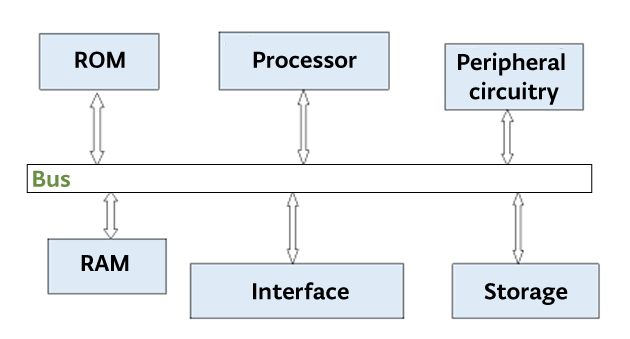
- Semiconductor Technology Now
Report Series
Embedded systems are spreading and gaining traction in society
Because of this, semiconductor ICs have advanced together with digital technology. Of these advancements, the role of the micro-processor and memory invented by Intel is the most significant. Thanks to these two devices, semiconductors and computers have advanced with alarming speed. And this computer technology is moving from “computers” such as mainframes, mini-computers, and personal computers to “embedded systems” which are not computers. An embedded system refers to a non-computer object that achieves its functionality with a system configured with a CPU and memory, just like a computer (Fig. 3). Remember that a computer is a machine that can provide various functionality by simply replacing or adding software. The reason a smartphone can take on new functionality by simply importing an app is because it is a computer.
 |
An electric rice cooker, a common appliance in Japanese households, is an example of an object that is actually controlled by a computer. A microcomputer is a semiconductor chip that is actually a computer reduced to its smallest possible form. This IC (integrated circuit) programs the cooking procedures and heat control to help cook tasty rice. By programming the microcomputer with the instructions for cooking rice, the heater in the rice cooker operates according to those instructions. *Incidentally, the instructions are well known by Japanese as a jingle, “start on low and heat up in the middle.” This makes it possible to eat rice of a consistent quality any time, every time. A rice cooker is therefore a computer system of sorts where the procedures for cooking tasty rice are specified in the software.
Successive waves of digitalization are optimizing tasks in the office and society, and even human activities, all of which were once thought impossible for a computer. Things like finishing work within a given time without working overtime, and following action procedures that can increase sales or providing services all become possible with digitalization. The idea is to control human activity with the interface circuit for sensors and microcomputers.
For example, an employee’s ID card can be embedded with an accelerometer or gyro sensor, and an infra-red sensor and a camera to capture the amount of the employee’s activity. This data is sent to a central server by radio. Even if the employee is constantly working at his/her desk, an accelerometer or inertial sensor such as a gyro sensor can detect the slightest motions which can indicate the employee may have stretched a little, or went to get some tea. And the infra-red sensor can indicate human interaction, such as talking to another person. Hitachi is developing a system that analyzes these types of body movements to estimate productivity in the office. According to this system, departments that have fun while working are more productive than departments that do not.
This can also be used in a production plant where the movements of employees are measured in order to visualize the conditions that produce the greatest work efficiency. For example, an analysis of the body movements can help find the optimal distance between workbenches or conveyor belts, or the best range of movement or height of a work bench. By using a 3D simulator to simulate the movement of the employees, it becomes possible to design the most efficient plant floor before actually building a plant.
This is not limited to factories. For example, consider the movement of personnel at a train station. Data that tracks the line of sight or other activities of station staff can be used to visualize optimal work efficiencies, such as placement of personnel or effective job assignment. The placement of supermarket employees can also be optimized through simulations that visualize placing staff where it will lead to increased sales.
RPA also supports digitalization
Digitalization is not just about the hardware we call computers. Some companies are starting to use robots configured with software to perform tasks in the office. For example, software robots such as RPA (robotic process automation) can aggregate documents created in Excel, Word, or in PDF or text format into an Excel table. It is necessary to specify beforehand a frame in Excel and the type of text to put into that frame, but as long as it is a predefined task, the robot can do it.
Robots can also accept and process orders from customers, and even follow up by sending email. Many of the tasks that humans perform in the office are predefined routines. Using RPA has reduced the amount of work in the office, and has allowed many companies to improve their business performance and to focus efforts of human resources on creating ideas.
Digitalization, including software robots, has made it possible to use computers for tasks that it was previously thought only humans could perform. Many of the machines in factories have become automated, and tasks performed by humans are being handled by robots. But computerization has been a slow process for office tasks and other white-collar jobs.
The background for using robots to perform office tasks that were once done by humans stems from an incident a few years ago where a new recruit committed suicide from overwork. This incident prompted business managers to seriously advocate work reforms. Until now, management only went so far as to introduce “no overtime days,” but this is not enough to actually lighten workloads. Most of the companies that have introduced RPA are now making top-down efforts to review and reform work.
Work reforms achieved by introducing RPA has had tremendous effect. For example, Softbank introduced it about a year ago and reports that in the department in which it was introduced, total overtime dropped by 9,000 hours. Using the reduced overtime hours to realize new ideas has improved motivation levels and increased work productivity.



















